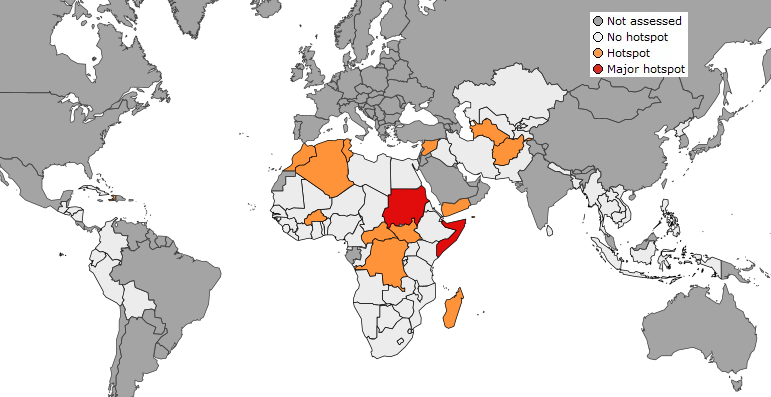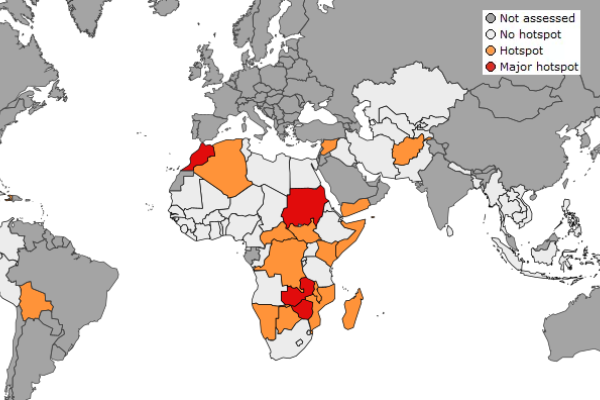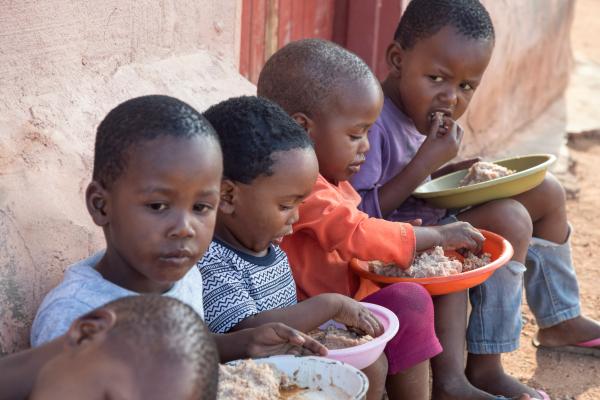
ASAP hotspot assessment July 2023
Main findings of the July global overview:
- The main cereal season has been completed in the Southern Africa region. Aggregate cereal production is estimated at ca. 11% above the 5-year average (FAO, July 2023). Sowing of winter wheat has been completed in South Africa; conditions are good, and the area planted is close to the 5-year average according to preliminary estimates.
- In East Africa, the second crop season in bimodal areas and the main crop season in unimodal areas have started well but are exposed to a high risk of insufficient seasonal rainfall, linked to the intensification of the El Niño, which typically leads to below-average rainfall in parts of Sudan and Southern Sudan, Ethiopia and Uganda. The need for humanitarian assistance in the region remains very high and is driven in particular by the nearly 25 million people in need of humanitarian assistance in the Sudan crisis and by the high needs in Ethiopia, Somalia and South Sudan.
- In West and Central Africa, crop conditions are generally favourable in the bimodal southern parts of the region, thanks to favourable rainfall throughout the past couple of months. Cumulative rainfall between June and mid-July has been positive in most areas of the Sahel benefiting crop development. However, below-average crop conditions are observed in Burkina Faso, northern Benin, northern Togo, and across the middle belt of Nigeria. The ongoing agricultural season is threatened by the insecurity and armed conflict that continue to affect livelihoods and impede access to croplands.
- In North Africa, at the end of the winter crop season, Morocco, Algeria and Tunisia are expecting crop yields clearly below the 5-year average, due to drought (May MARS Bulletin). In contrast, the harvest of winter cereals ended in the Middle East with good prospects, except in north-eastern Syria (Hassakeh), north-western Iraq (Ninewa) and parts of Iran (Golestan, Khorasan, Ardebil). In Iraq, rice cultivation has been banned in Najaf and Qadissiya as in 2018 and 2022. In Yemen, although crop and rangeland conditions are good, food insecurity continues to affect 17 out of 30 million people.
- In Central Asia, the harvest of winter cereals ended with mixed prospects: poor in Turkmenistan, below average in Kyrgyzstan and southern Kazakhstan, but good in Uzbekistan (except Kashkadarya) and Tajikistan. Biomass of spring wheat is below average in northern Kazakhstan and there is also some concern for summer crops and pastures due to a possible lack of irrigation water in Turkmenistan, Uzbekistan and Tajikistan. In South Asia, planting and growth of summer (kharif) crops in Pakistan and growth of wet season (aman) rice in Bangladesh are ongoing under favourable conditions.
- In continental South-East Asia and the Philippines, planting of main season rice is now ongoing under good conditions except in some northern parts of Thailand, where rice was not planted yet due to lack of rainfall. In Indonesia, prospects for dry season rice to be harvested from July to October are close to average. In North Korea, biomass of rice and maize, to be harvested from end August, is above average thanks to favourable rainfall conditions.
- In Latin America and Caribbean islands, vegetation conditions are average to above average. However, the forecasted drier than normal conditions in the next two months could have a negative impact on ongoing sowing activities. Central American countries are facing poor harvest prospects in large areas of their cropland due to water deficits accumulated since the start of the season.
The next assessment is scheduled for the end of August 2023.
Details
- Publication date
- 8 August 2023
- Author
- Joint Research Centre
- JRC portfolios




